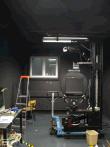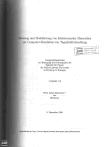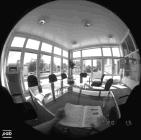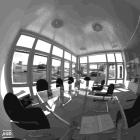


(note: these pages refer to the gonio-photometer built by me around 1990 at Fraunhofer ISE, Freiburg. For the newer 2004 gonio-photometer pgII, developed at pab Ltd, please check the pab Ltd website.)
For the previous design and setup of the gonio-photometer at FhG-ISE see Diploma/master work.
After the diploma/master, a new Xenon light source became available, and measurements continued on more window materials:
 |  |  |
During my PhD, the diploma work of Jochen von der Hardt changed the linear drive to a then available circular rail system, so the detector moved on a 170deg arch. The advantages were a constant detector distance, larger angular coverage and only one lamp instead of two. Jochen also thought up and wrote the BSDF integration using spherical Voronoi diagrams, which allows comparison to integrating sphere data. This had been part of validation work, including angular precision and verification of detector linearity over a large dynamic range.
 |  |  |  |
Above BSDF data example was again visualised using the new mountain program in 2012, around 15 odd years later. Note the adaptive
algorithm operating along scan-lines. Data-points are shown as pink dots.
The image on right is the last photo of this design before it was dismantled 25 September 2013. Pretty much on the spot 24 years after it
was initially completed.
Thomas Schmidt's diploma work shaped some ideas how to correct near field photometry to far field photometry, which are still very
interesting, since they do this with an numerical approach ("ill-posed-problems").
Mathias Braun's diploma work extended these ideas from 2D to 3D and worked on a large, homogeneous illumination system.
If you're interested, these works are probably still on file at ISE, or feel free to contact me
for a PDF file.
Visualisation of BSDF data became an important topic too, and 3D-graphics accelerated UNIX workstations: At that time Evans&Sutherland still stuck to line-drawings, Stellar/Ardent had merged to form Stardent, Hewlett-Packard based their 3D on their Starbase library, and Silicon-Graphics was a about to switch to X11 as window system. We tested HP and SGI on site at ISE, hands-on (what else ?), with one mountain version written for Starbase and one for IRIS GL. Luckily for the group, Fraunhofer bought a Silicon-Graphics VGX320 machine, based on a proposal by me. After that, interactive 3D display became a key technology to understand measured BSDF.
PhD in Physics got finished at University of Freiburg and Fraunhofer ISE in 1995.
The work was about the concepts, measurement methods and models needed to add new window materials to existing daylight simulation programs.
New window materials include scattering samples (e.g. Aerogels, Polymers) or light redirecting materials (like reflective or refractive
steel/glass Venetian blinds).
The simulation program used was RADIANCE.
Here's the PDF file (in German, sorry). Update: Note that the BSDF section in the old pdf had some very ugly typos
concerning cos(theta_in), which should have read cos(theta_out). Mea culpa.
Images show the test room, the library at ISE in 1995, where Aerogel double-pane glazing and honeycombs had been tested in-vivo:
- more details to be added -
| photo (Nikon fish-eye) | simulation result | |
 |  | 
|
included me in various industrial work, e.g. an ISE project on solar lighting at the new Potsdamer Platz in Berlin and
my very enjoyable trip to Sydney's UTS to consult on roof material for the main stadium at the Sydney Olympics.
(see DOI website for the DOI index system)
Many folks made my ISE years very enjoyable. Thanks to Prof Volker Wittwer, Prof Adolf Goetzberger, Prof Joachim Luther for running a nice institute and specifically to the original crew I knew from earlier ISE days. After all, this is not a social side, so not a longer list of names here. Thanks to all for an interesting, joyful and fruitful experience.